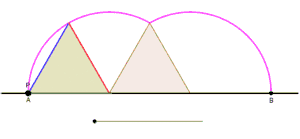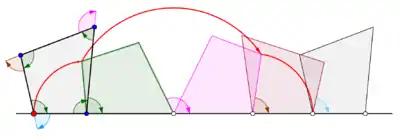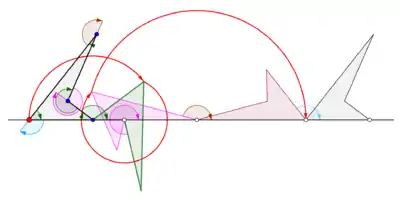In geometry, a cyclogon is the curve traced by a vertex of a regular polygon that rolls without slipping along a straight line.[1][2]
In the limit, as the number of sides increases to infinity, the cyclogon becomes a cycloid.[3]
The cyclogon has an interesting property regarding its area.[3] Let A denote the area of the region above the line and below one of the arches, let P denote the area of the rolling polygon, and let C denote the area of the disk that circumscribes the polygon. For every cyclogon generated by a regular polygon,
Examples
Cyclogons generated by an equilateral triangle and a square
 Animation showing the generation of one arch of a cyclogon by an equilateral triangle as the triangle rolls over a straight line without slipping. |  Animation showing the generation of one arch of a cyclogon by a square as the square rolls over a straight line without slipping. |
Prolate cyclogon generated by an equilateral triangle

Curtate cyclogon generated by an equilateral triangle

Cyclogons generated by quadrilaterals



Generalized cyclogons
A cyclogon is obtained when a polygon rolls over a straight line. Let it be assumed that the regular polygon rolls over the edge of another polygon. Let it also be assumed that the tracing point is not a point on the boundary of the polygon but possibly a point within the polygon or outside the polygon but lying in the plane of the polygon. In this more general situation, let a curve be traced by a point z on a regular polygonal disk with n sides rolling around another regular polygonal disk with m sides. The edges of the two regular polygons are assumed to have the same length. A point z attached rigidly to the n-gon traces out an arch consisting of n circular arcs before repeating the pattern periodically. This curve is called a trochogon — an epitrochogon if the n-gon rolls outside the m-gon, and a hypotrochogon if it rolls inside the m-gon. The trochogon is curtate if z is inside the n-gon, and prolate (with loops) if z is outside the n-gon. If z is at a vertex it traces an epicyclogon or a hypocyclogon.[4]
See also
References
- ↑ Tom M. Apostol, Mamikon Mnatsakanian (2012). New Horizons in Geometry. Mathematical Association of America. p. 68. ISBN 9780883853542.
- ↑ Ken Caviness. "Cyclogons". Wolfram Demonstrations Project. Retrieved 23 December 2015.
- 1 2 T. M. Apostol and M. A. Mnatsakanian (1999). "Cycloidal Areas without Calculus" (PDF). Math Horizons. 7 (1): 12–16. doi:10.1080/10724117.1999.12088451. Archived from the original (PDF) on 2005-01-30. Retrieved 23 December 2015.
- ↑ Tom M. Apostopl and Mamikon A. Mnatsaknian (September 2002). "Generalized Cyclogons" (PDF). Math Horizons. Archived from the original (PDF) on 2005-01-30. Retrieved 23 December 2015.